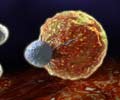A new genetic modification method enables genes in living T-cells in mice to be modified quickly and efficiently.

TOP INSIGHT
New genetic engineering method allows targeted gene surgery in T-cells and opens up new perspectives for research into the immune system, and possibly for the development of new T-cell-based therapies.
For their study, the researchers, led by Professor Lukas Jeker from the University of Basel and University Hospital Basel, took T-cells from a mouse and cultured them in the lab. They then used a plasmid - a proven delivery vehicle - to introduce two elements into the cells via an electrical impulse: RNA molecules, which attach to a specific section of double-stranded DNA, and the protein Cas9, which cuts the DNA at this site.
The ensuing, frequently faulty repair often switches off the gene. It is also possible to rewrite individual DNA building blocks in the genetic material, but this is much more difficult and less efficient. Two days after taking them out, the cells are transferred back into mice.
Fully functional
The altered T-cells survived in the recipient mouse and were fully functional: they multiplied, migrated to lymph nodes and the spleen, and behaved as expected during an infection. They thereby fulfilled the prerequisites needed for the potential therapeutic use of genetically modified T-cells.
"Our method allows targeted gene surgery in T-cells and opens up new perspectives for research into the immune system, and possibly for the development of new T-cell-based therapies," says Lukas Jeker, Professor of Experimental Transplantation Immunology and Nephrology at the University of Basel.
Source-Eurekalert
 MEDINDIA
MEDINDIA
![Genetically Modified Food / Genetically Modified Organism [GMO] Genetically Modified Food / Genetically Modified Organism [GMO]](https://images.medindia.net/patientinfo/120_100/Genetically-Modified-Food.jpg)



 Email
Email





